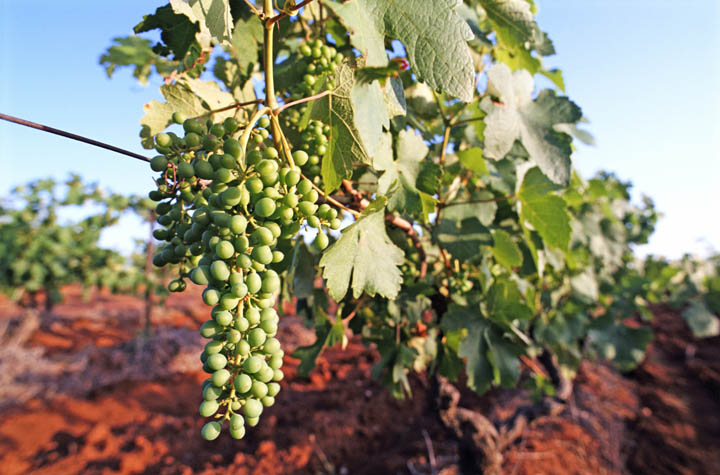
The relatively large amounts of rainfall in the Eastern U.S. — in North Carolina, around 40 inches annually — can be a problem for wine grape growers. That moisture tends to fuel the growth of the vine canopy — the leaves on a grape vine — and an unusually leafy canopy can be a problem for growers.N.C. State scientists hope to determine the optimum width the strip beneath grape vines should be so that vine canopy growth is inhibited just the right amount to produce the best grape yield and quality.
November 9, 2010

The ground beneath vineyards and what grows there — in addition to grape vines — could play a role in making wine grape growers in North Carolina and elsewhere along the East Coast more competitive and profitable.
That is the thinking behind a North Carolina State University study of the way wine grape growers produce grapes. N.C. State is one of six universities involved in a five-year study funded by a $3.8 million grant from the U.S. Department of Agriculture’s National Institute of Food and Agriculture. Virginia Tech is the lead institution in the study. Scientists up and down the eastern seaboard will be engaged in a range of projects designed to determine how wine grapes can be grown more competitively in the Eastern U.S.
Excessive rain produces large canopies
N.C. State will receive $841,111 over the five-year life of the grant, said Sara Spayd, professor of horticultural science at N.C. State and North Carolina Cooperative Extension viticulture specialist. Spayd said the N.C. State part of the project will focus largely on determining the optimum way to treat the ground beneath rows of grape vines.
She explained that the relatively large amounts of rainfall in the Eastern U.S. — in North Carolina, around 40 inches annually — can be a problem for wine grape growers. That moisture tends to fuel the growth of the vine canopy — the leaves on a grape vine — and an unusually leafy canopy can be a problem for growers.
If vines grow too vigorously, Spayd explained, fruit quality and yield can be reduced. Growers can spend considerable time and money dealing with excessive canopy growth. Eastern growers are often forced to trim canopies, which adds to the cost of producing grapes. And a big, leafy canopy tends to hold humidity, which can lead to fungal diseases, and gives insects a place to live and hide, both problems that can add to the cost of producing grapes.
Space between vine rows research
Researchers hope to find a more cost-effective way of managing vine canopy vigor. Spayd said most growers plant grass — usually fescue — in the space between rows of vines while leaving a weed-free area or strip of bare ground 1 or 2 feet wide directly beneath the vines. But what grows between the vines influences canopy growth and vigor and grape yield and quality. Spayd explained that grass or other plants growing among grape vines use moisture and nutrients that would otherwise be available to the vines.
So what Spayd and other N.C. State scientists hope to determine is the optimum width the strip beneath grape vines should be so that vine canopy growth is inhibited just the right amount to produce the best grape yield and quality. Preliminary research in North Carolina has demonstrated that weed competition and strip width beneath the vines can influence grape vine growth and yield.
Working at RayLen Vineyards in Mocksville, the scientists will compare different scenarios ranging from nothing but bare ground beneath the vines to a vineyard floor completely covered by grass. In some cases, researchers will allow weeds in the usually weed-free strip to compete with the vines to see how the presence of weed competition impacts the vine canopy.
Spayd said a team of scientists from N.C. State’s College of Agriculture and Life Sciences has been assembled to work on the project. Weed scientists are involved with establishing fescue and monitoring weeds growing on the vineyard floor and assessing impacts on the vines. Soil scientists will study how different treatments influence the moisture available to vines and vine nutrition. Plant pathologists will look at any differences in disease pressure. Spayd will determine how the different treatments impact vine physiology and fruit quality. Economists have been enlisted to document demand for East Coast wines. Another faculty member will assess how the project impacts the grape and wine industries on the East Coast.
Regional effort to improve grapes
“The point is to help (Eastern) growers compete better with other (wine growing) areas,” Spayd said. “This is a very regional approach. It’s a very coordinated approach.”
While Virginia Tech is leading the effort, Cornell University, the University of Maryland, The Ohio State University, Pennsylvania State University, and the Connecticut Agricultural Experiment Station are also involved in the project.
According to Tony Wolf, professor of viticulture at Virginia Tech and project director, the scientists involved in the project will also study frost and winter injury problems, unique grape varieties and the high costs of grape production that result from the relatively small scale of most Eastern vineyards. Consumer buying preferences and perceptions about regional wines relative to other domestic and foreign brands will also be part of the study.
You May Also Like



